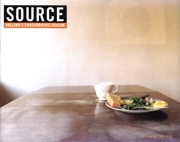Vulnerable Fragility
'Blind Angels' by Marie Jo Lafontaine, Orchard Gallery November - December 1998
Review by Mairin Murray
Issue 17 Winter 1998
View Contents ▸
Marie Jo Lafontaine is an artist from Brussels, internationally celebrated for a body of work comprising of video works and photo installations. The exhibition titled 'The Blind Angels' in the Orchard Gallery consists of two video installations and the photowork 'Kids of the Ruhr Valley', consisting of eleven large scale photographs inside the gallery and five smaller photographs above the entrance to the gallery. Lafontaine's work and indeed the title for one of the video pieces draws on sentiment expressed by the poet Rainer Maria Rilke who wrote in 1912, "For Beauty's nothing but beginning of Terror we're still just able to bear, and why we adore it so is because it serenely disdains to destroy us. Every angel is terrible."
In the Visitor's Book at the Orchard many comments refer to the mesmerising and hypnotic effects of both the video installation pieces. One particular comment about the photographic series 'Kids of the Ruhr Valley' gets close to my own view about the work. The person claims: "These photo's aren't angelic, but do show vulnerable fragility - ignore all the PC mush that inform some critics!"
The photographic work consists of eleven large scale, portrait format photographs, in black and white, of children shown from the waist up, unclothed. The photographs are mounted in large wooden surrounds, with a rectangular block of one colour inset underneath the photographs. The encasing of the photos is very effective, reminiscent of religious icons, which are often exhibited in their original wooden surrounds. The starkness of the composition and the use of the blocks of colour however also suggests the visual language of fashion advertisements, in particular the Benetton series, where children of different ethnic origin are often used.
By virtue of children being the subject matter of the work, there is a certain vulnerable fragility to these photo images. Most of the children look straight ahead with a few looking down, as though avoiding eye contact, from which one can infer that some exhibit signs of submissiveness or fear. However I think it would take a huge implausible leap to concur with the written information about the piece, that, "They reflect the humanitarian concerns of the artist in their studies of the psychological disposition of children living in this deprived area."
'The Kids of the Ruhr Valley' is almost identical in format to an earlier work (1989) by Lafontaine comprising of black and white, head and shoulder images of women, entitled 'Savoir, retiner et fixer ce qui est sublime.' This work similarly sought to express the humanitarian concerns of the artist however the complexities attributed to both elude me.
Five photos of children are placed on an outside wall above the entrance to the Gallery. The format of the photos is the same as the images inside, though without any wooden surround. Three of the children hold guns while two place their hands up to their eyes as though afraid to look. It is to a point shocking and unsettling to see images of children playing with and pointing guns. However with no visual clues provided to the children's circumstances and environment, I found it difficult to be moved by the piece. Again the photos, due to their format and the absence of signs of reality or authenticity, reminded me of the type of images used in advertising, in this case the cover image of an early U2 album. I also couldn't help being reminded of work by Louis Jammes who produced photographs of children from Sarajevo, full length frontal format with grafted angels wings on them, which was placed around Dublin. This work did have a poignancy and a power to shock and jolt people out of complacency which is I feel missing from the photowork by Lafontaine.
The video installations are, as stated in the visitor book, hypnotic and mesmerising, with terror being captured very powerfully. Both video pieces show an appreciation of life's fragility, and hint at ever present group, ethnic and societal violence. The photoworks while depicting the fragile vulnerability of children are for me much less intense, with a cool calmness which, when contrasted to the video works, appears all the more serene and precious. To understand the humanitarian concerns of the artist a visual context is necessary.
Other articles on photography from the 'Portraiture' category ▸






